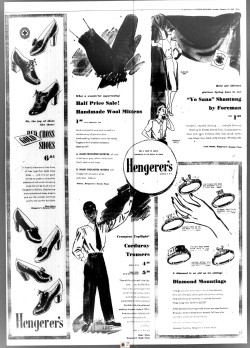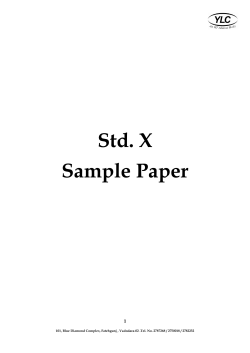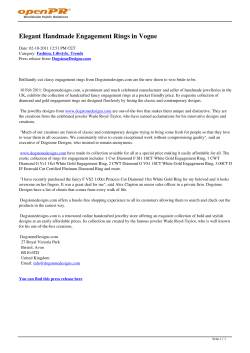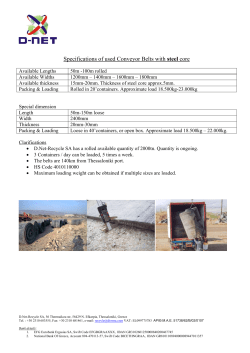
XTEM sample prep for dummys Nathan Gray University of Utah
XTEM sample prep for dummys Nathan Gray University of Utah Materials Science and Engineering Graduate Research Assistant Necessary Equipment • • • • • • • • • Epoxy: I used Mbond 610 available at Ted Pella. Also can use G1 or epotex. Crystalbond Thermoplastic wax: flows at ~120 C, used for temporary mounting. Monopod or Tripod handlap: I used a Gatan model 623 Disc Grinder D500i Dimpler (The original!) or Gatan 656 Dimple Grinder (substandard) Ion Mill. I used the Fischione model 1010 at BYU. Also could use the Gatan Duo Mill (currently broken in UofU basement). Diamond polishing paste: 15 µm, 9 or 6 µm, 3µm, 1µm, 0.25µm, 0.01µm (I found that for 0.01µm grit size colloidal silica in suspension works better for some materials) Diamond lapping paper (same sizes as above, down to 1µm) Polishing pads- I used a (different) biege Chempad for 1 and 0.25µm, and Red Final C for final 0.01µm polish. Both available at Allied High Tech. Slotted Cu or Cu washer TEM specimen mount Step 1 – make a sandwich • Cut sample into two 2mmx2mm squares. You could use a wafer saw if you’ve got a nice big sample, I had to use a diamond scribe and cleave mine. • Cut another two 2mmx2mm pieces of a dummy substrate (ex. Si) You will be making a 2x2x2mm cube. My substrates were all 0.5mm thick so 4 together makes 2mm. If your substrates are a different thickness you’ll want to get as wide a sample possible without exceeding 2.3mm (max width to fit it onto a 3mm diameter TEM sample washer mount). • Reason for sandwich: end product will be more mechanically 2mm stable and handle-able (due to thick regions left around the edges after the dimple). Not absolutely necessary, but helpful. 2mm 2mm Step 1 • • • • After cleaning the surface of the film, apply a layer of adhesive (Mbond) to directly to the surface of one film Place the other piece film down (films are facing eachother and connected with adhesive) and gently press down with tweezers to make a decent contact. Place this in a small clamp or vise and carefully tighten (NOT TOO MUCH!!!) in order to make a very thin glueline. Optional: Teflon tape on clamp surface to prevent unwanted sticking Cure on a hot plate or in an oven. Recommended cure time for Mbond 610: 2 hours at ~175 C or 1 hr at ~150C. Films + adhesive interface vice 2mm vice 2mm 1mm Step 1 • Take one Si piece, rough surface with sandpaper, apply adhesive, stick on one side of your substrate sandwich and repeat clamp/cure procedure (I usually skimp on the cure time since I’ll be curing again in the next step.) • Repeat with the other Si piece. Now you have your 4-layer thick cube Silicon Substrate Substrate 2mm Silicon film/glue/film 2mm 2mm Step 2 – make it a cube • • • • • • Unless you’ve cleaved and glued the pieces perfectly, you have four uneven edges. Follow this procedure to make all sides coplanar and smooth Place a 9mm diameter x 9mm height Al or pyrex cylindrical sample mounting stub on a hot plate set to medium-low heat (~120 C should be plenty) Put a few flakes or a small chunk of thermoplastic mounting wax (crystalbond) in the middle of the stub and wait for it to liquify. Mount the sample as shown. Get it as straight as possible. Using rough grit (320 or 400) Silicon Carbide sandpaper flatten the top. Sand parallel to the interface lines. Start by holding pyrex mount with fingers. Once flattened, switch to 600 grit paper and handlap disc grinder. Water optional. Heat, remove, remount, and repeat sanding until all both pairs of sides with interfaces are flat and coplanar (and normal to interface) Step 3 – flat polish side 1 • • • • • • • • • Side one needs to be polished with a series of decreasing grit sizes until there are no scratches under optical microscope (near the interface you want to look at.) Rule of thumb: polishing can leave scratches up to 3X the grit size. So on the subsequent step remove at least that thickness of material. Use the monopod handlap and just do everything by hand until you get to the diamond paste step (I used diamond lapping paper on a flat glass plate) be very gentle! Advance the monopod micrometer 10-20 µm at a time. Cutting rate can be very rapid, so check thickness often (using calipers: 1/1000”=25 microns) 600grit sandpaper ≈ 15 µm grain size. Clean the sample by rinsing thoroughly with water between each grit size change. Pure Deionized water is best for small grits. After the 1 µm step, use the 8” polishing wheel with a pad, polishing paste, and extender fluid (Metadi fluid). Still use the handlap, run the wheel at 100-200 rpm (don’t let go!) Wheel usage: Cover the wheel with water, put the adhesive pad on, and push it down with a gloved finger. Spin it up and apply extender fluid to wet the nap. Stick a pea sized (or less) amount of diamond paste on and smear it in with your finger. Polish! Final thickness isn’t that important (you can just measure it before the next step. Try to stay thicker than 250 µm. Colloidal Silica: This will recrystallize and contaminate the pad or suspension with grains larger than 0.05 microns. To avoid this you must rinse the pad thoroughly immediately after use, and wipe down the rim of the suspension container with cotton swab or kimwipe or something before replacing the lid. Pure water works better than extender fluid with this. Step 3 – flat polish side 1 • Official recipe (Courtesy of Dr. Jeffrey Farrer, BYU TEM lab manager) • Replace 30 min with 10 min for very soft materials like Si Grit Size Padded Amount of Material removed 30 µm 200-500 µm 15 µm 90 µm 6 µm 45 µm 3 µm 18 µm 1 µm 10 µm Time 1 µm √ 30 min 0.25 µm √ 30 min 0.1 µm √ 30 min 0.05 µm √ 30 min Step 3 • That recipe is kind of open to interpretation. Here’s what I usually did: Grit Size Padded Amount of Material removed Time Final Thickness 15 µm (600 grit SiC sandpaper) As much as needed 325 µm (13/1000”) 3 µm Diamond lapping paper 50 µm 275 µm (11/1000”) 1 µm Diamond lapping paper 25 µm 250 µm (10/1000”) 1 µm Diamond paste √ 0.25 µm Diamond paste √ 0.05 µm colloidal silica suspension √ ~5-10 µm 10 min ~1-5 µm 10 min ~0-1 µm 10-20 min Sometimes I skipped this step and added 10-20 min on the next Between 240-250 Step 4 – Measure the Thickness! • • • • • • • • • • • • Remove the sample from the pyrex mount by heating or soaking in acetone. I broke one by ultrasonicating so avoid that. MEASURE THE THICKNESS as accurately as possible. Best way: Use the D500i Dimpler Glue a circular glass microscope slide coverslip on top of the Dimpler sample mount platen using thermoplastic wax. Make the wax layer as thin and uniform as possible. Keep the top very clean. Install the mount on the Dimpler Put a tool on the dimpler arm (i.e. steel dimpling tool, described later) Rotate the shaft the tool is mounted on slowly, until the “tool index” LED lights up on the control panel. Make sure the force is set to ~15 grams. Switch the toggle to Z Push “arm down.” Zero the LED display readout using the Z-offset knob. Push “arm up.” Place clean sample in the center of the platen mount. Push “arm down.” Record the number on the readout. This is the sample thickness in microns. Repeat the measurement a few times to ensure accuracy. A good thickness reading at this point is paramount to your success! The measurement usually varies by ± 5 microns. Any more than that means mount is probably not flat, so you should reheat and reposition or replace the glass coverslip. Step 5 – mount to Cu washer • Make sure you’ve measured the thickness • Brush a small amount of Mbond 610 adhesive on the top of a Cu TEM specimen holder. • Quickly mount your sample polished side down onto the grid, before the solvent dries. Center it as accurately as possible. • DO NOT get any glue near the interface on the bottom, or sticking up higher than the edges. If you do, remove the sample and clean it off with an acetone soaked q-tip, and start over. • Cure for a few hours on hot plate (~150 C) Step 6 – Dimple polish • • • • Mount sample to Dimpler specimen mount with crystalbond. Use enough to fill in the gap between the bottom sample surface and the glass slide, for support, but not so much that the glue sticks up farther than the sample surface. Make sure sample is laying perfectly flat (coplanar with specimen mount surface). Install specimen mount on Dimpler sample stage hex shaft. With the first dimpling tool installed, set Dimpling parameters (force=15 grams, speed=20, damping=6), rotate tool shaft until tool index LED lights up, and press lower arm. Set Z-offset to the sample thickness measured previously (make sure it’s not a negative offset). Now the display always shows the current thickness of your sample. Sample mounted on Cu washer Glass or sapphire coverslip Specimen mount (platen) Dimpling Tool Step 6 – Dimple Polish • Mix diamond paste with Metadi extender fluid using a fresh q-tip (on a glass slide) • Raise dimpler arm, carefully dab some diamond slurry onto specimen, and on the dimpling tool while it is spinning. • Lower arm, and dimple until desired thickness, following recipe outlined. Add more slurry when necessary. Careful not to put any force on the tool when applying slurry. • When changing grit sizes, remove the specimen and rinse thoroughly with DI water, and then either clean very well or use another dimpling tool. • For padded steps, use a dimpling tool with a thin strip of Red Final C or another polishing pad glued on. Making this will be outlined later. • Trust the dimpler. It knows how thick your sample is! • Final specimen thickness should be 10-20 microns. • Check for scratches under optical microscope. Keep on polishing with col. Silica (final step) until scratches are no more. Step 6 – Dimple Polish • My Dimpling recipe. Switch to force = 5g and speed = 10-15 for 1 µm and lower steps. Grit Size Padded Amount of Material removed Time Final Thickness 9 µm Diamond paste As much as needed 3 µm Diamond paste 50 µm ~3-5 min 25 µm 1 µm Diamond paste 10 µm ~1-3 min 15 µm ~1-3 µm 5 min Sometimes I skipped this step and added 10-20 min on the next ~0-1 µm 5 min Not very ~0-1 µm 20-35 min 10-15 µm 1 µm Diamond paste √ 0.25 µm Diamond paste √ 0.05 µm colloidal silica suspension √ 75 µm Step 6 – Dimple polish • Heat and remove glass coverslip from platen with sample still attached. • Soak in acetone until all glue is dissolved. Remove sample+grid and rinse with methonal. • Check under microscope for cracks, dirt, and glue. Repeat cleaning steps until it’s reasonably clean. • Put it in a safe place (teflon tape wrapped sample cases are good makeshift cello-sample holders) • Clean you polishing pad! Don’t leave any colloidal silica in fibers. Step 7 – Ion Mill • • • • • Take it to BYU Bakeout Dewer following instructions in Fischione 1010 manual. When starting pumpdown, press down hard on sample chamber door to make sure it seals. Often it won’t automatically make a seal. Mount sample on gear with interface aligned with notches (use vacuum tweezers in TEM rooms) Test Ion guns: Open ion mill program, make sure vac is at 2e-5 torr, set gun voltages to 5 kV, and currents to 5 mA, and push start. Make sure everything is stable. If it’s not, say a prayer and try again Step 7 – Ion Mill • Vent chamber, insert specimen as shown. Step 7 – Ion Mill • Replace lid, Pump down • Add liquid Nitrogen to Dewar and make sure heat conduction knob is engaged (fully clockwise. Located just behind dewar on back of machine.) Cooling prevents deformation of sample caused by heating during milling. • Open Argon tank valve (regulator Pressure <200 kPa) • Set Milling Parameters to the following: – – – – – Gun voltage (both) : 3.5 kV (varies. 5 kV for slower mill-rate samples) Gun current (both) : 5 mA Mill angle : 12º Stage rock : ± 20º Rotate 180º : every 1:30 min • Hit Update • Hit Start Step 7 – Ion Mill • Swing microscope viewer and fiber optic light over viewing window and slowly lower as far as it will go. • Focus on interface with using micrometer stages, focus adjuster, and TV viewer. • Close the shutter when your not watching so you don’t sputter all over the window. • Sit back and watch the fireworks. My samples have taken anywhere from 4-8 hours total mill time. • Check every 10-20 minutes for perforation, indicating that you’re done. (As long as it’s thinned at the interface. If not keep milling until you reach the interface.) Si shows red and then yellow transparency with transmitted (chamber) light. Also interference fringes should appear just before perforation. • That’s it! Just disengage the dewar rod, and hit stop, then vent, and wait while sample is warmed and then pressure is increased. Remove and have a look under the TEM!
© Copyright 2025














